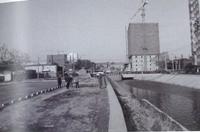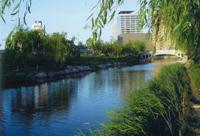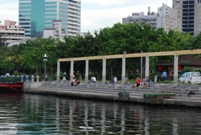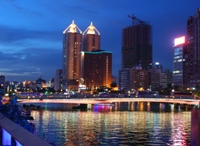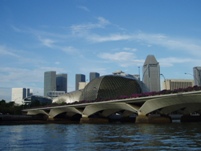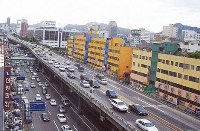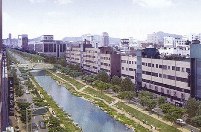
< World's WATERFRONT: WORLD TOP >
|
Before restoration
|
|
After Restoration
|
Zhuanhe River flowing through Beijing was once an important river preventing flooding and supplying water to the outer moat around Beijing Castle. However, during the 1975-to-1982 period, land was reclaimed from the river along with urbanization and many factories and houses were constructed in the reclaimed area. Along with the growing importance of the waterfront environment in the city, however, the City of Beijing started a project to restore Zhuanhe River to its original state in May 2002.
One of the big features of this project is Beijing’s unprecedented awareness of river conservancy, and the project was conducted under the principle of “human-oriented river development to seek harmony and coexistence with nature.” On the premise that river functions are achieved to connect local history and city life organically, this project provides six landscape areas comprising a historical cultural area, ecological park, stone-arranged water scene, waterfront corridor, water garden, and green water channel, without damaging the ecosystem.
By JRRN-secre | category: Restoration Project,China | Comment(0) | Trackback(0) |
Date: 2009.01.05 16:06
Kaohsiung City is the second-largest city in Taiwan. It has the 3rd-largest container port behind Hong Kong and Singapore, playing a role as the ocean entrance of Taiwan. It is a lagoon city representing Taiwan, which has been developed from the center of the waterfront to the periphery with the concept of “sea city” or “waterside castle city.”
In the past, people turned their backs on “Love River,” which flows through Kaohsiung, due to water pollution and the bad smell. But in about 1985, a water contamination countermeasure plan was drawn up. Since then, water quality improvement projects including sewer work have been conducted. Today, there are walking trails provided along the water, roadside trees planted along the water, and pleasure ships operated. It is the symbol of regeneration of Kaohsiung.
>>More details, “Workshop on Urban River Restoration, Love River in Kaohsiung, Taiwan”
By JRRN-secre | category: Restoration Project,Taiwan | Comment(0) | Trackback(0) |
Date: 2009.01.05 16:04
Along the midstream and downstream of Yangtze River, the number of lakes connected to the river drastically decreased from a hundred to three. As a result, the lakes’ ecology was badly destroyed, and their flood prevention and water storage abilities were quite damaged. In 1998, Yangtze River experienced the secondly largest flood after 1954. As post-disaster measures, total measures including constructing hydraulic systems, preventing epidemic, rebuilding housing areas, restoring ecosystem, and appealing for international cooperation, are decided as the nation and are now in operation. Nature restoration has been underway, focusing on wetlands.
>>More details (PDF 33KB)
By JRRN-secre | category: Restoration Project,China | Comment(0) | Trackback(0) |
Date: 2008.03.31 19:45
Gyon-an River restoration project was started with the idea that the best river ecosystem is the one in harmony with the sound recreation and cultural activities. The project aims at restoring and maintaining the natural functions of the Gyon-an River’s ecosystem for a better life and global environment, and at realizing a clean innate river culture.
The basic principal adopted to realize the above is the ecological approach. The project is the first approach in Korea in that it keeps the natural shape to the maximum, and it is a steppingstone to restoring the river course and the basin‘s wetland.
By JRRN-secre | category: Restoration Project,Korea | Comment(0) | Trackback(0) |
Date: 2008.03.31 19:44
River straitening and drainage development for preparing farmlands started in the late 19th century. By 1968, 95 % of the river was modified and 4000-ha farmland was transformed to cultivated field. But its effects on the environment and the restoration plan were investigated for twelve years, and based on the results, the interested parties negotiated to reach an agreement. In June of 1999, the biggest restoration works in the north Europe started, with the budget of 35 million dollars. It included land acquisition, as well as projects regarding soil, water, and roads, and was called “Skjern River restoration project.”
>>More details (PDF 32KB)
By JRRN-secre | category: Restoration Project,Europe | Comment(0) | Trackback(0) |
Date: 2008.03.31 19:43
Urbanization caused the pollution of Singapore River whose water became dark and unclean. In order to revitalize the river, strict measures were taken including pig farming prohibition in the area, and moving roadside food vendors, who had discharged wastewater, into buildings.
Singapore imports the half of its water from rapidly-growing Johor Bahru in the neighbor country Malaysia. The country has been eagerly working on: water development using domestic catchment; recycling sewage; and importing water from multiple sources.
>>More details (PDF 38KB)
By JRRN-secre | category: Restoration Project,Other Asina Countries | Comment(0) | Trackback(0) |
Date: 2008.03.31 19:42
The San Francisco Bay area consists of nine counties, with the population of 650 million and the dimension of 19400 km2. Each county has its own land use plan. Around thirty years ago, the San Francisco Bay Conservation and Development Commission (BCDC) was established by the residents who were concerned about the waterfront reclamation by the rate of 10 km2 every year. Based on the annual budget of four billion dollars, BCDC has been granted with the wide-ranging powers of making various political decisions as an agency, including the power to protect the existing port, the power to build recreation facilities for the citizens, and the power on the airport and on the wildlife preserve. With the budget of four billion dollars, various projects have been implemented together with the local government, and the local economy has continuously been vitalized. One example is the waterfront restoration program (Calfed Bay Delta Program) in Calfed Bay Delta area where Sacrament and San Joaquin waters flow into the San Francisco Bay. The program promotes environment restoration over more than thirty years, focusing on the fields of drinking water quality and of ecosystem conservation.
>>More details (PDF 40KB)
By JRRN-secre | category: Restoration Project,North America | Comment(0) | Trackback(0) |
Date: 2008.03.31 19:24
The scenery of Rhine River in Netherlands has dramatically changed by centuries of human activities such as creating banks that decreased anti-flood fields; agricultural use of anti-flood fields; river course improvement for transportation; and massive wastes disposal. It resulted in deterioration of Rhine River’s environment. In 1970s, the aquatic life in the river was contaminated by harmful chemicals, and the river was called “sewage in Europe.”
Especially after 1986’s chemical factory fire in Sandos, Switzerland, the water quality was deteriorated. People grew conscious on environment, and created “Rhine River activity plan” targeting at “salmon living river by 2000.”
By the end of 1980s, thanks to the efforts by the surrounding local governments, the environment was recovered to a level to be quoted as a hygienic excellence.
>>More details (PDF 39KB)
By JRRN-secre | category: Restoration Project,Europe | Comment(0) | Trackback(0) |
Date: 2008.03.31 19:24
From 1860s, there was a river development in upstream of Rhine (Basel – Bingen) aiming at flood prevention and inland river transportation. In 1930s, river improvements were done for hydraulic power generation and inland river transportation. Treaty of Versailles after the World War I gave France a right on Rhine River, and France established a new channel for river transportation, parallel to Rhine River. As a result of these changes, anti-flood fields were diminished and flood frequented in the upstream region. Given the situation, a comprehensive Rhine River flood control plan was proposed. By restoring and conserving anti-flood fields, Rhine River’s flood control functionality (estimated 270 million m2) is expectedly recovered. Governmental agencies and NGOs operate focusing on water quality improvement, free fish inhabitation and relocation, and habitat variety improvement.
>>More details (PDF 42KB)
By JRRN-secre | category: Restoration Project,Europe | Comment(0) | Trackback(0) |
Date: 2008.03.31 19:23
Missouri River, a largest and the longest river in North America, has been widely modified over these 150 years.
However, as the American people grew aware of the environmental ethics, they came to focus on the deterioration of the major rivers in the country, and to reexamine the river management priority. As a result, some national laws and state laws were established, and many measures to support restoring a number of major rivers in America were provided. For Missouri River, based on the Missouri River Mitigation Act (an act of compensation for environmental destruction), a project was implemented, which restored the wetland and the riverside forests, changed the banks and weirs, and reunited the “chutes” (water channels for high water) with the mainstream.
>>More details (PDF 33KB)
By JRRN-secre | category: Restoration Project,North America | Comment(0) | Trackback(0) |
Date: 2008.03.31 19:22
Mersey River was polluted as the industrial revolution proceeded, and for two hundred years, it had been deemed as the most polluted river in Europe. Its water environment started to improve in 1960s. The financial and environmental restoration activities were started for the Mersey River basin that had the problems of declining economy, devastated cities, and environmental issues.
From 1980, as a project to clean up the river mouth, a 15-year investment plan (170 million pounds or 34 billion yen) for cleaning the sewage wastewater was started by the government. From 1985, this effort was continued as Mersey River Basin Campaign, run mainly by the environment ministry. It is a 25-year program with the total budget of four billion pounds invested by the government and companies. It is a “world-encouraging advanced example” and is highly evaluated in EU as well as in UK.
>>More details (PDF 36KB)
By JRRN-secre | category: Restoration Project,Europe | Comment(0) | Trackback(0) |
Date: 2008.03.31 19:21
Waza-Logone Floodplain ranges over 8000 km2. It has the people with various businesses who base their lives there, and has rich biodiversity. However, after a dam to support the local economy and living was constructed, the natural functions of the floodplain were lost. The social and economic impacts of the lost floodplain were serious, loosing over 50 million dollars of basis for human life in the twenty years after the dam construction.
Approximately 8000 households suffered from the direct economic damages of over two million dollars a year, caused by the decreased dry-season grazing, fishing, yields of natural resource, and surface water supply. The suffered were mostly stock farmers, fishers, and dry-land farmers who represented the poorest and the weakest group in the region.
>>More details (PDF 32KB)
By JRRN-secre | category: Restoration Project,Africa | Comment(0) | Trackback(0) |
Date: 2008.03.31 19:21
Evergrades in Florida had a wetland called “river of grass,” formed by water flowing in the dimension of 2.9 million acres (11700 km2) from Okeechobee Lake.
Kissimmee River had experienced water quality deterioration and aridification, caused by farmland reclamation and flood prevention. After the flood in 1947, river improvement construction was conducted to straighten the river course, which changed the shape of the river. Now Evergrades is proceeding a world biggest project for wetland conservation and restoration with the total cost of 7.8 billion dollars. Kissimmee River’s once straightened river course has been re-winded in order to recover the wetland.
>>More details (PDF 33KB)
By JRRN-secre | category: Restoration Project,North America | Comment(0) | Trackback(0) |
Date: 2008.03.31 19:19
Shanghai is a big city with the population of 16 million (including 3 million guest laborers). Forests of tall buildings are observed along the opposite bank of PuDong’s economic deregulation area.
Shanghai, estimated by the World Bank, will grow into a city of 25-million population by 2010. It is among the big cities developing at the “Arian speed” and the “Chinese scale.” Therefore the problems that accompany urbanization is quite noticeable.
>>More details (PDF 40KB)
By JRRN-secre | category: Restoration Project,China | Comment(0) | Trackback(0) |
Date: 2008.03.31 19:18
Most rivers in southwestern region (SWR) of Bangladesh depend on water flow from Ganges River. The flow volume declines during the dry-season and it impacts the region. Many of the branch rivers of Ganges River are blocked off from Ganges River due to the water intake at the upstream Indian Farakka Barrage that was built in 1975. Gorai River, a branch of Ganges River, is one of the major sources of freshwater supply to SWR and is the only one remaining branch river. However, in at least these twenty years, its flow volume in the dry-season (December – April) has been declining. It has a serious environmental impact: especially along the coastal areas around the sanctuary forests where the salty water has increasingly been intruding. In December 1996, the Bangladesh government decided to implement “Gorai River Restoration Project (GRRP)” to meet the urgent need of dredging Gorai River to restore the dry-season’s flow volume in SWR and the regional ecological balance. The research has been in progress through EGIS (Environment and GIS, Dhaka) for the problem of the Gorai River’s declining flow volume, and various alternatives and technological solutions have been studied (by the School of Geography, University of Leeds, UK). The Gorai River’s inflow point used to be closed in the dry-season, but thanks to the dredging with the PPW (Pilot Priority Work) Program, through the investments by the Dutch and Belgian governments, it has come to be kept in an open condition.
>>More details (PDF 35KB)
By JRRN-secre | category: Restoration Project,Other Asina Countries | Comment(0) | Trackback(0) |
Date: 2008.03.31 19:18
The primary elements to decide the ecological environment of a large river and the neighboring floodplains are the scope, the period, and the dynamics of hydrologic connection between the river and the floodplains via the surface layer current and the groundwater. That hydrologic connection has been badly lost in all the large rivers in Europe, due to water channel improvement constructions and to dam constructions. For Danube River which flows along the jurisdiction of Austrian “alluvium area national park,” as the first step of restoration strategy for freely-flowing river, a large-scaled pilot project has been in progress to restore the hydrologic and ecological completeness of the system between the river and its floodplains.
>>More details (PDF 38KB)
By JRRN-secre | category: Restoration Project,Europe | Comment(0) | Trackback(0) |
Date: 2008.03.31 19:17
As industries were developed and population increased, the inflow burden on Chesapeake Bay was increased. As a result, the bay, which was closed, became gradually polluted. Aiming at regaining rich natural environment, the federal government and the state government, with cooperation by near-shore waters concerned parties, established “Chesapeake re-program” in 1987. Many of the concerned parties participated in this program, including the federal government’s Environmental Protection Agency (EPA), National Oceanic and Atmospheric Administration (NOAA), the universities and research institutes in the relevant four states, and NGOs. This program focused on restoring fish and marine life in the bay, and its activities included: prohibiting phosphorous detergents, improving agricultural management, organic removal of nutrient salts, the sewage system and wastewater regulations, and the
penetration of environment education among people. Mitigation works were conveyed, and wetland restoration and seaweed bed creation were also started. After an agreement in 2000, this program has much progressed and has contributed to conserving and recovering the environment in the bay.
>>More details (PDF 32KB)
By JRRN-secre | category: Restoration Project,North America | Comment(0) | Trackback(0) |
Date: 2008.03.31 19:16
Cheonggye River used to flow between Chongro and Uruchiro, but it became an underdrain after being covered by a road, and by another elevated road. But after thirty years after construction in 1968, Cheonggye elevated road became old. In recent years measures such as reenforcement and heavy vehicle restriction were taken, but the road became dangerous for use. In 2002, Yi Myongpac, who committed to solving the problems, removing the road, and restoring the river, won the election of the mayor. Given that, Cheonggye River restoration project was rapidly put into shape. This is the world’s first case of urban re-development project removing the road and restoring the river, and collects people’s interest worldwide.
>>More details (PDF 44KB)
By JRRN-secre | category: Restoration Project,Korea | Comment(0) | Trackback(0) |
Date: 2008.03.31 19:14
Boston Bay restoration project is one of the largest in scale in the States involving 43 cities, 2 million people, 5500 enterprises, 11-year construction, and 3.8 billion dollars of cost. The United States Massachusetts water resource bureau, established in 1997, not only adjusted the 43 cities’ interests but led a project hiring a number of expert staff, and gained a great number of citizens’ cooperation to secure the financial sources required for the project (public involvement).
Boston Bay restoration project has substantially improved the water environment in the bay. It has given the local people the sense of confidence and pride, and is said to have contributed to activating the local economy.
>>More details (PDF 54KB)
By JRRN-secre | category: Restoration Project,North America | Comment(0) | Trackback(0) |
Date: 2008.03.31 19:11
